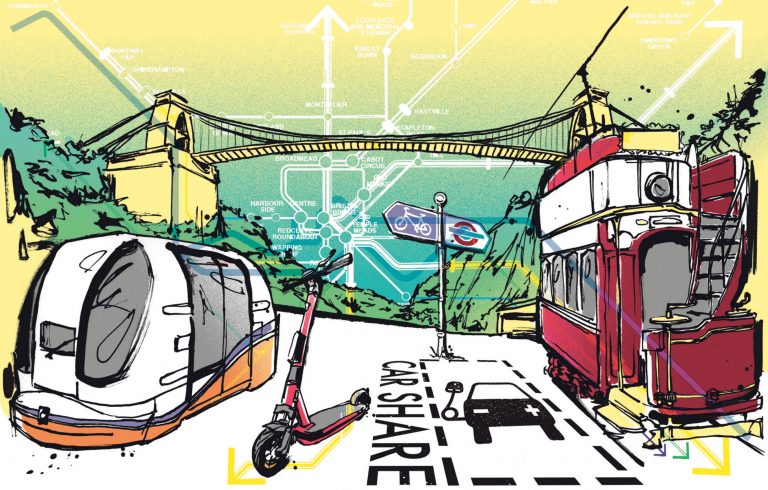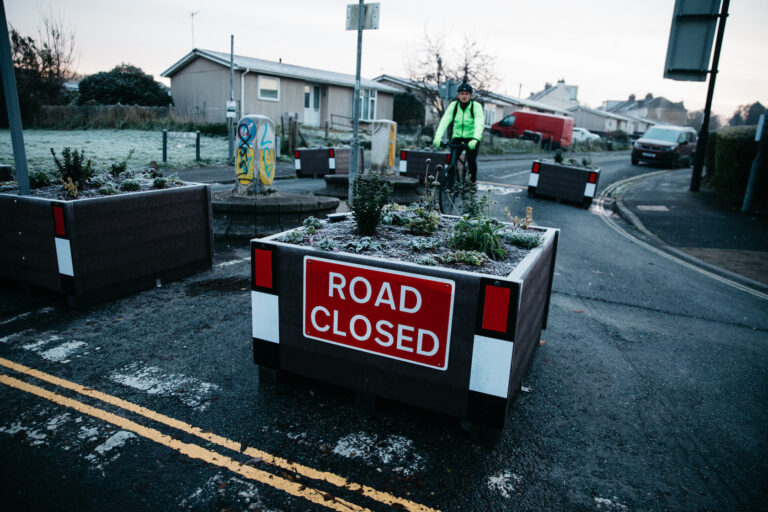Analysis: It’s time for politicians to come together on mass transit

Illustration: Scott Luís Masson
In two weeks, the West of England’s leaders will gather to consider a new report that has concluded that underground sections are needed and achievable in Bristol’s future mass transit system.
This important development – revealed by Bristol Live earlier this week – is the culmination of years of fraught debate and political posturing over how we will one day get around a city that has built a reputation for crap public transport.
The debate has been hotly contested by two sides. Bristol Mayor Marvin Rees has been pushing for some form of Bristol underground since 2017 as the only viable option because entirely overground routes such as trams would cause huge disruption and in some places wouldn’t work at all because of Bristol’s narrow main roads.
But this idea has received constant criticism from those – including Green councillors and more recently Metro Mayor Dan Norris – who favour something overground because they see an underground system costing billions as just pie in the sky.
The leaked report was unsurprisingly welcomed this week by Marvin Rees. “A mass transit system with underground sections where needed is deliverable for £7-9 billion, says WECA,” he tweeted. “Pleased to see a growing consensus around the need for transformational transport change locally, as Bristol deserves nothing less.”
This comes after months of squabbling between Rees and Norris over feasibility studies and figures on how much the mass transit system might cost.
Dan Norris gave a categoric “No” when asked on BBC Points West in February if the region would ever get an underground. Days later, an unpublished report leaked to the Local Democracy Reporting Service concluded that the scheme would cost between £15billion and £18billion – which Rees slammed as a “deeply flawed” cost estimate.
Rees then said: “The lack of ambition of both Bristol City opposition councillors and the combined authority is staggering.
Green councillor for Windmill Hill Ed Plowden, recently told the Cable: “On rapid transit, we would improve our existing bus network first – rolling out far more bus lanes on the main corridors that don’t have them and increasing the protected space on the ones that do,” Plowden says.
“Over time this could create the conditions for tramlines,” he adds. “But in the short term we
need to work with what we have – we cannot afford to pin our hopes on plans for expensive projects which may not get funding, or disruptive heavy engineering or tunnelling.”
Rees will only be in power until next May’s local elections, when Bristol scraps the mayoral system for a committee system. Labour and the Greens are likely to be the two main parties, and it’s arguably more important than ever that they can work together and with WECA on long term projects to transform the city.
What does the new report say?
The report by WECA transport officers, which will be brought to the meeting of regional leaders on 6th October, recommends the approval of the research so far and that work begin to develop a more detailed outline business case for the mass transit system.
The report, which has been seen by Bristol Live, assesses all the previous studies and presents different options for overground and underground sections the four corridors: South West to Bristol Airport; South East to Bath; East to Kingswood, Emersons Green and Cadbury Heath; and North up Gloucester Road to Filton and Cribbs Causeway.
The report says underground sections would be more reliable and quicker, and therefore popular, and also cause less disruption, but because of the huge extra costs could make it hard to convince investors that it is worth the money. Although overground sections would be cheaper to build, they would cause major disruption to the roads during construction and would require reallocation of space away from cars.
But the report’s authors conclude that a combination of above ground and tunnels is achievable, and the project should progress to the next stage to find a solution.
In response to the reporting by Bristol Live on the leaked WECA report, Councillor Emma Edwards, who leads the Greens, said: “With complex transport projects the devil is in the detail and we obviously can’t comment on a leaked report we haven’t seen being spun by the Mayor’s Office.
“Greens have long supported the idea of some form of mass transit system for Bristol along with improved cycling and walking infrastructure, and have repeatedly called for an open comparison of all the options – so we can see which would be the best value for money, deliverability and carbon impact. It seems extremely unlikely the best option on any of those criteria would involve any significant amount of underground construction.
“Let’s be honest – when neither of the two big parties are willing to even commit the money to rebuild the UK’s crumbling schools, the idea of them stumping up several billions of pounds to dig tunnels in Bristol is ludicrous.”
With a general election also looming, time will tell whether Edwards’ comments are accurate.
What can we learn from France?
Our recent deep dive into mass transit systems across the channel found that the introduction of trams in Bristol’s twin city Bordeaux was a success in that it is very well used and it reduced car journeys and increased walking and cycling.
But if all that sounds rosy, it’s not the full story. The years of construction caused traffic jams and press criticism, and in recent years the trams have attracted flack for being too busy, slow and unreliable.
Although underground systems are more expensive, some French cities have built them at a reasonable cost. Rennes, which is half the size of Bristol, has two lines with a driverless lightweight automatic vehicle metro. It carries three times the passengers per mile of Bordeaux’s trams, at nearly double the speed, but its cost per mile was nearly four times Bordeaux’s latest tramline.
What needs to happen?
As the examples from France show, there is clearly no silver bullet and whatever mass transit system we end up will have pros and cons.
Marvin’s vision for an underground – or more accurately a mass transit system with underground and overground sections – has been used as a stick for his opponents to beat him with. But the latest findings by WECA transport officers lend weight to this idea.
Now that we are progressing to the next stage of the process – to further narrow down the options and develop a more detailed business case – we need our politicians to engage constructively with the options on the table and be open to collaboration and compromise.
On the eve of the referendum last year, when Bristol – or more accurately, 28.6% of the city’s registered voters – opted scrapping the mayor for a new committee system, we said that whatever the result the city’s political culture needed a reset after becoming so divided and sometimes toxic.
The committee system is an opportunity for the biggest parties to work together to find solutions to the major challenges we face as a city. And maybe mass transit is the best example of this. After years of politicians scoring points and bickering, it will take years to scope out the options, choose the best system, get funding for it and make it a reality. The person or party at the wheel will likely change along the route, but we can’t afford political infighting or indecision to cause delays or stop us from reaching our destination.












Report a comment. Comments are moderated according to our Comment Policy.
Bristol had a tram system before the Second World War and it could easily do so again, if we could rid ourselves of the ‘car is king’ mentality and take a leaf out of the book of many historic European cities.
Bristol is a character-full and relatively small city which could be enhanced by appropriately designed trams and the architecture that goes with them. I for one would prefer to view the city at a moderate and sociable pace from the surface than to hurtle through dark tunnels beneath it!
It looks as though WECA is plumping for Mayor Rees’s underground metro scheme, with some overground bits, because it has not seriously considered alternatives, despite large sums of money spent commissioning consultants’ reports delivering widely diverging cost estimates.
It is difficult to believe that a metro system involving substantial underground workings in central Bristol can be delivered at less than half the £19 billion cost of the Elizabeth line in London.
Overground sections of a metro, if rail based and requiring a segregated rail infrastructure, could also be costly if it led onto land purchase from a patchwork of private owners. There could also be legal disputes over land use.
The Elizabeth Line took 30 years to complete because of all the complications involved.
Trams which could be used on existing road networks would be far more cost effective, notwithstanding pain caused to motorists. The latest generation of advanced rapid (tram) transport being trackless does not require tramlines.
It’s best to reserve a final decision until Bristol’s new governance structure is in place.
I have just come back from travelling and visited both Medellín in Colombia and La Paz in Bolivia. Both had cable car systems that were fantastic. They were convenient, offered amazing views and inexpensive for the community to travel on. They opened up both cities to locals and tourists alike and weren’t intrusive (in my humble opinion) and made little to no noise. They seem a pretty green option though admittedly I don’t know the ins and outs of how they are powered, but I’m sure the offset of traffic fumes in itself is enough of selling point. The La paz system cost 234million dollars which is a fraction of the number being floated about for an underground. I was informed by the locals it took a mere 6 months to complete the first 3 lines and it has continued growing the number of lines since that initial installation. Seems to me this is a no brainer